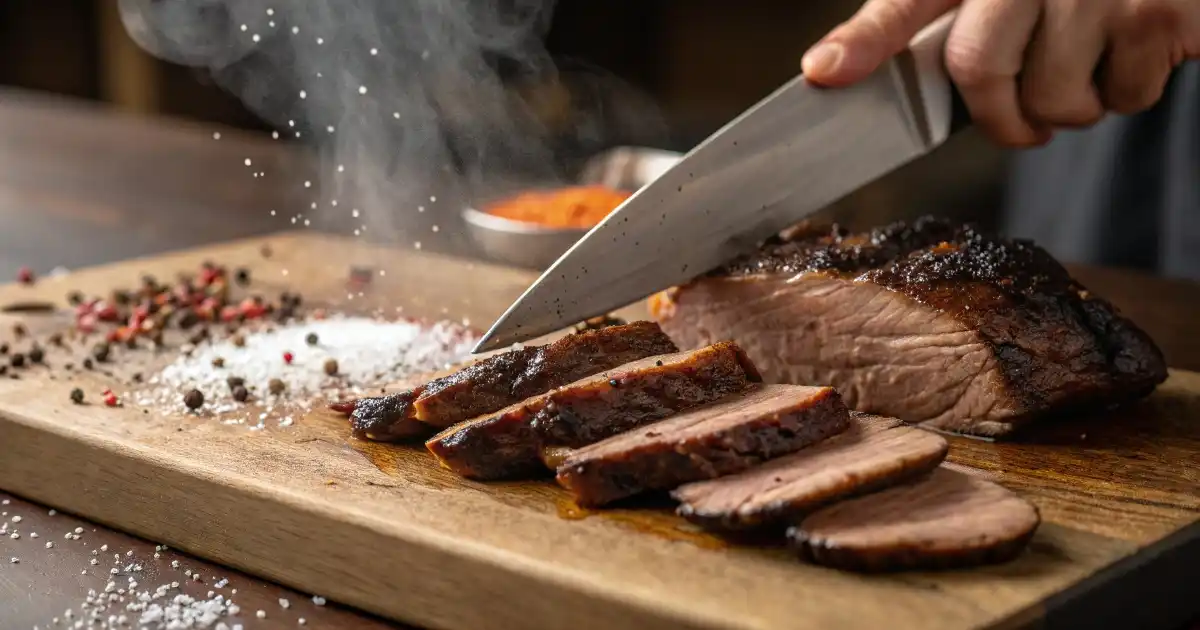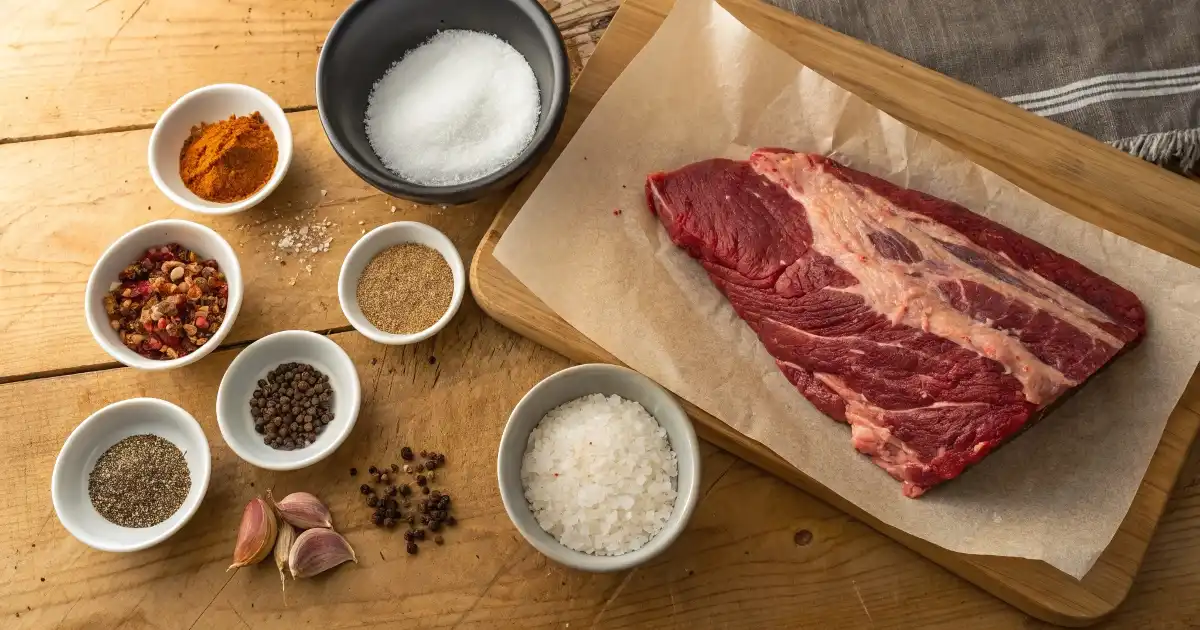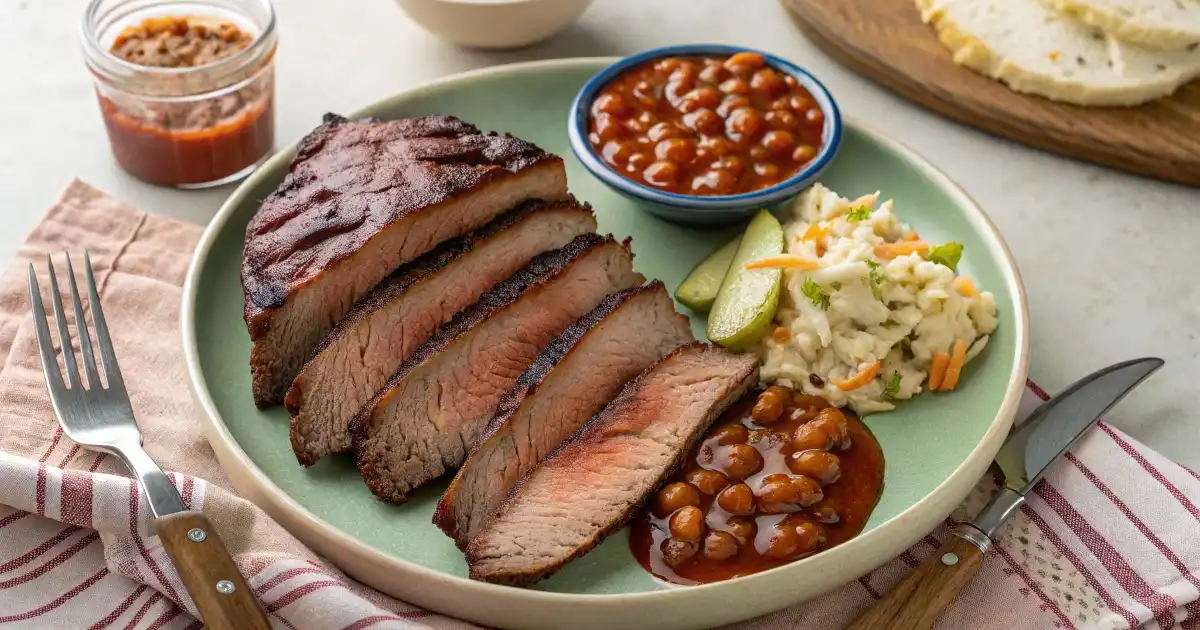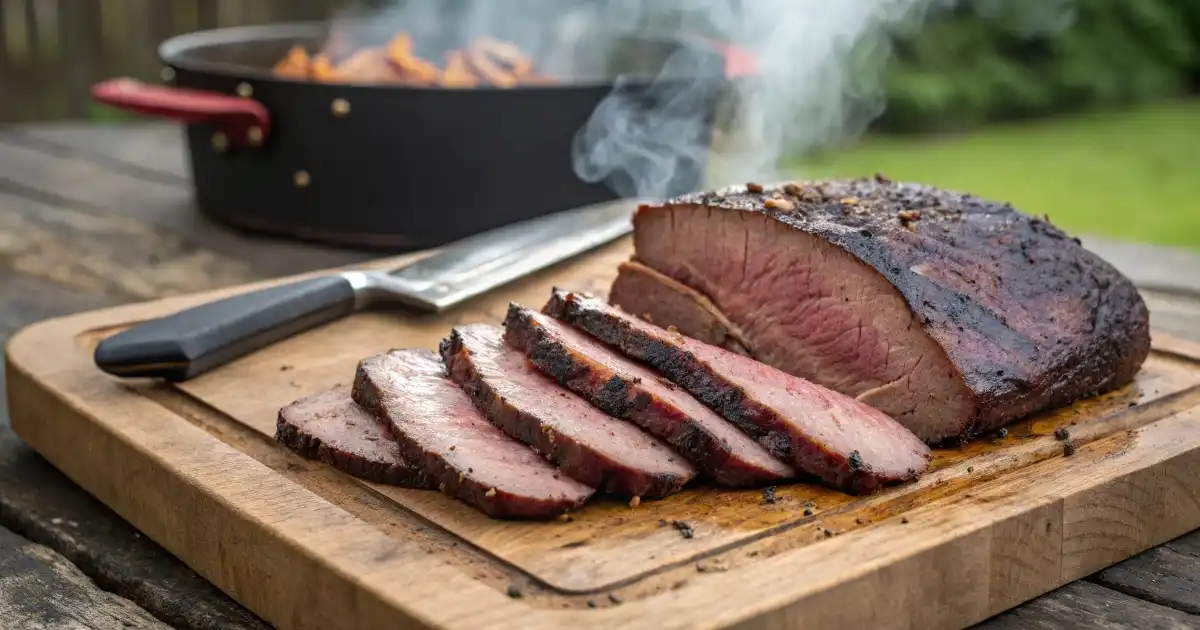Sliced beef brisket is a mouthwatering cut of meat known for its rich, beefy flavor and melt-in-your-mouth texture. It typically comes from the lower chest of the cow and requires low-and-slow cooking techniques to maximize tenderness. When done properly, sliced beef brisket becomes a sensational dish that delights families, barbecue enthusiasts, and curious home cooks alike.

Table of Contents
Introduction
Picture your taste buds dancing with joy as you sink your teeth into a slice of tender, smoky, and oh-so-satisfying sliced beef brisket. There’s something about that succulent bite—the aroma lingering in the air, the juices glistening on the surface, the hearty chew that practically melts away—that captures your senses. If you’ve ever daydreamed about hosting a backyard cookout with family and friends gathered around, passing plates laden with sliced beef brisket, this is the perfect place to start planning.
In this article, you’ll learn every aspect of preparing sliced beef brisket so that each piece is bursting with flavor. We’ll talk about selecting the right cut, applying rubs or marinades, cooking techniques (both classic and modern), serving suggestions, and beyond. By the end, you’ll feel equipped and excited to create your own delicious sliced beef brisket feast, whether you plan on using a traditional smoker, a slow cooker, or even an oven. Let’s dig in!
Disclaimer: This article is for informational purposes only and does not replace medical advice. Always consult reliable sources and expert professionals when handling and cooking meat to ensure food safety.
Why Sliced Beef Brisket Is So Special
Sliced beef brisket holds a beloved place in American culinary culture—particularly in Texan barbecue traditions—due to its unique combination of deep, savory flavor and remarkable tenderness when cooked correctly. The brisket cut is situated in the lower chest area of the cow. This location means brisket must support a large part of the animal’s weight, developing robust muscle fibers and connective tissue. It might sound intimidating, but with patience and the right technique, those tough fibers transform into melt-in-your-mouth magic.
Because of its shape and composition, brisket is typically sold in two parts:
- Flat (First Cut): Leaner and more uniform, perfect for neat sliced beef brisket presentations.
- Point (Second Cut): Thicker, more marbled with fat, excellent for burnt ends or chopped brisket dishes.
When it comes to sliced beef brisket, most people favor the flat portion because it provides lean yet tender slices once cooked low and slow. Yet, don’t overlook the point, as its extra intramuscular fat can yield an intensely flavorful experience.
Selecting the Best Brisket for Sliced Beef Brisket
A delicious final product starts with a quality raw ingredient. Whether you choose a prime-grade brisket from the butcher or a choice-grade brisket from the supermarket, keep these tips in mind to ensure you bring home the best cut for your sliced beef brisket endeavor:
- Marbling
Look for light ribbons of fat throughout the meat. This marbling keeps the brisket moist during lengthy cooking sessions and contributes to a richer flavor. - Size & Shape
Make sure your brisket is manageable for your cooking setup. If you have a smaller oven or smoker, a massive full packer (12–15 pounds) may be overwhelming. A 5–7 pound brisket flat is more user-friendly and yields plenty of sliced beef brisket to feed several guests. - Color
Choose brisket with a deep, rosy color. Avoid any discolored or grayish hues, which may suggest the meat is not at its freshest. - Fat Cap
You want a nice layer of fat on top—enough to keep the meat protected and basted as it cooks, but not so thick that you end up paying for waste. A ¼-inch fat cap is considered ideal by many pitmasters.
According to the USDA’s guidelines on beef grading and selection, prime-grade brisket typically offers more marbling, meaning it stays juicy and flavorful. However, choice-grade can also yield amazing sliced beef brisket results with proper cooking techniques.
Pre-Cooking Preparations
Trimming
Before you begin any seasoning or cooking process, you’ll want to trim your brisket. While some pitmasters prefer a more generous fat cap, others prefer minimal fat to let their rub shine. For ideal sliced beef brisket:
- Trim away any large, hard chunks of fat.
- Keep around ¼ inch of the fat cap on top.
- Square off any dangling or scraggly edges that may burn during cooking.
Pro Tip: If you plan to use the brisket point for other preparations like burnt ends, separate it carefully from the flat after cooking and trim excess fat so each piece cooks evenly. But keep in mind, if you intend to serve both as sliced beef brisket, you can keep them connected until serving time.
Seasoning & Rubs
The beauty of sliced beef brisket is that it pairs well with simple, bold flavors. A classic Texas-style brisket relies on a simple rub of coarse salt and black pepper (sometimes called the “Dalmatian rub”). This minimalistic approach allows the natural flavor of the beef to shine. That said, you can elevate your sliced beef brisket with other seasonings. Popular additions include:
- Paprika for color and subtle sweetness
- Garlic powder or granulated garlic for extra savory goodness
- Onion powder for deeper aroma
- Cayenne pepper for a little heat
Consider an overnight rub rest. Coat the brisket in your chosen seasoning mixture, wrap it in plastic wrap or place it in a sealed container, and refrigerate it for 8–12 hours. This approach helps the flavors penetrate the meat, setting the stage for a richly flavorful sliced beef brisket.
Marinating (Optional)
Marinating is an alternate route for those who desire an extra layer of flavor or moisture. For instance, a Korean-inspired marinade typically involves soy sauce, sesame oil, ginger, garlic, and a bit of sugar or pear juice for sweetness. Whether you choose a marinade or a dry rub depends on personal preference and the cooking method you intend to use.
Remember, if you plan to incorporate a marinade, pat the brisket dry before cooking to achieve a nice bark (that tempting outer crust) rather than a steamy surface.
Classic Low-and-Slow Smoking for Sliced Beef Brisket
When most people think of sliced beef brisket, they imagine the authentic barbecue smoke ring and the tantalizing bark. Smoking is the time-honored method that has given brisket legendary status in places like Texas.
Basic Steps
- Preheat Your Smoker
Aim for a temperature range of 225°F to 250°F. Wood selection matters, too: hickory offers strong, traditional flavors, while fruit woods like apple or cherry add a milder, subtly sweet note. - Position the Brisket
Place the brisket on the smoker grate with the fat cap facing up or down, depending on your preference. (Many pitmasters put the fat cap on top to self-baste the meat, while others argue the fat cap on the bottom helps shield it from direct heat.) - Low-and-Slow Cook
Keep the temperature steady. Cook times can vary, but a common guideline is 1–1.5 hours of cooking per pound of brisket at around 225°F. A 10-pound brisket can take anywhere from 10 to 15 hours. Patience is key. - The Stall
Expect a temperature “stall” around 150°F–160°F, where the internal temperature of your brisket won’t budge for a while. This is normal. Some choose to wrap the brisket in butcher paper or foil at this point to hasten cooking and preserve moisture—this technique is called the “Texas Crutch.” - Target Internal Temperature
According to expert pitmasters, the sweet spot is often 195°F–205°F for succulent sliced beef brisket. Start checking for tenderness around 195°F. Insert a probe or toothpick, and if it slides in with minimal resistance, your brisket is ready to rest. - Resting Period
After removing the brisket from the smoker, wrap it in foil or butcher paper and let it rest in an insulated cooler (without ice) or a warm oven (turned off) for 30 minutes to 2 hours. Resting helps redistribute the juices and ensures each sliced piece is moist and flavorful.
Slicing Tips
Once rested, place the brisket on a sturdy cutting board. Slice against the grain—this shortens the muscle fibers, making each bite of your sliced beef brisket easier to chew. Aim for slices about ¼ inch thick. Thinner slices can dry out quickly, while thicker slices might be too chewy.
Oven-Roasted Sliced Beef Brisket
Not everyone has a smoker, but that doesn’t mean you can’t enjoy delicious sliced beef brisket. An oven can replicate the low-and-slow environment, though you’ll miss out on the smokiness (unless you add liquid smoke or smoked spices).
- Preheat the Oven
Set it to 275°F. This slightly higher temperature compared to typical smoking accounts for the enclosed environment and helps maintain consistent cooking. - Season Generously
A simple dry rub or marinade is perfect for oven-roasted sliced beef brisket. Make sure to coat all sides before placing it in a roasting pan. - Add Moisture
Place a small amount of beef stock or water in the bottom of the roasting pan. This helps keep the environment moist. Cover tightly with foil to trap steam. - Check the Internal Temperature
Cook the brisket until it reaches an internal temperature of around 195°F–200°F. Calculate about 45 minutes to 1 hour per pound, but rely on your thermometer to be sure. - Optional Uncovering
Near the end of cooking (or once the brisket hits around 180°F), you can remove the foil to help develop a crust. - Rest, Then Slice
Once it’s done, let the brisket rest, still tented with foil, for at least 30 minutes. Then, slice against the grain for that perfect tender bite.
Slow Cooker Method for Sliced Beef Brisket
If convenience is paramount in your life, slow cooking can still yield a surprisingly good sliced beef brisket with minimal fuss. Though you won’t get the classic bark or deep smoke essence, you’ll still have incredibly tender slices that are perfect for sandwiches, tacos, or pairing with a tangy sauce.
- Trim & Season
Lightly trim the brisket to fit your slow cooker, if necessary. Apply your favorite rub, or use a marinade overnight. - Sear for Flavor (Optional)
Quickly sear the brisket in a hot skillet with a bit of oil. This step adds depth of flavor by creating a browned crust. - Place in Slow Cooker
Arrange onion slices, garlic cloves, or other aromatics at the bottom. Place the brisket on top, fat side up, and add a small amount of beef broth or sauce. - Long Cook
Set the slow cooker to low for 8–10 hours or high for 5–6 hours, but the low setting is typically better for a tender sliced beef brisket. Resist the urge to lift the lid often; it releases heat and slows cooking. - Check Doneness
Aim for an internal temperature of about 195°F–200°F, or until a fork slides in easily. - Rest & Slice
Carefully remove the brisket, let it rest for about 15–20 minutes, then slice across the grain. The slices may be extra tender—great for sandwiches or simple weeknight dinners.
Korean-Style Sliced Beef Brisket
For a flavor fusion, consider a Korean-inspired take on sliced beef brisket. Traditional Korean BBQ often uses thinly shaved brisket (chadolbaegi), quickly grilled at the table. However, you can adapt these flavors to a slow-cooked, tender approach as well:

Marinade Ingredients
- Soy sauce
- Sesame oil
- Grated ginger
- Minced garlic
- Brown sugar or honey
- Gochujang (Korean chili paste) for spice (optional)
Marinate the brisket for 8 hours or overnight. Slow-cook or roast at a low temperature until tender. Serve your sliced beef brisket with steamed rice, kimchi, and an array of banchan (Korean side dishes). The result is a sweet-savory, slightly spicy brisket with a complex umami kick.
Serving Ideas for Sliced Beef Brisket
Once you have this beautifully cooked brisket, the possibilities are endless. Here are a few serving suggestions to spark your imagination:
- Classic BBQ Plate
Pile your sliced beef brisket on a platter with sides like coleslaw, mac and cheese, baked beans, and cornbread. Offer a tangy barbecue sauce on the side. - Sandwiches
Layer sliced beef brisket on a sturdy roll (like a brioche bun or ciabatta) and top with pickles, onions, or even a crunchy slaw. A drizzle of spicy or sweet BBQ sauce completes the picture-perfect sandwich. - Street Tacos
Warm soft tortillas, load them with sliced beef brisket, and top with fresh pico de gallo, sliced radishes, or pickled onions. Finish with a squeeze of lime. - Hearty Salads
Top a bed of leafy greens with sliced beef brisket, tomatoes, cucumbers, shredded cheese, and crispy onions. A creamy dressing or vinaigrette can tie it all together. - Hash or Skillet
Chop leftover sliced beef brisket into chunks, and toss it into a skillet with diced potatoes, peppers, onions, and your favorite seasonings for a hearty brunch dish.
No matter how you choose to serve your sliced beef brisket, it’s almost guaranteed to be the star of the meal. The key is to experiment, have fun, and savor each juicy bite.
Beyond the Basics: Tips, Tricks, and Troubleshooting
Bark Development
A deep, dark bark is the hallmark of a well-cooked smoked brisket. If you find your brisket lacking that signature crust, try these tips:
- Increase the black pepper in your rub for a thicker bark.
- Allow the brisket surface to dry slightly before placing it in the smoker (pat off excess moisture).
- Avoid excessive foil wrapping during the cooking process. If you wrap, open it near the end to crisp the exterior.
The “Texas Crutch” Debate
Using foil or butcher paper to wrap your brisket around 160°F–170°F speeds up cooking and can help retain moisture, but it may soften the bark. Wrapping is a personal preference—some love the convenience, while others feel it compromises the texture. If you choose not to wrap, just be prepared for a longer cooking process.
Smoke Flavor Overload
Too much smoke can lead to bitter, acrid flavors. Aim for a thin blue smoke from your smoker. Thick, billowy clouds indicate incomplete combustion, which can leave your sliced beef brisket tasting overly smoky or even sour.
Dry or Tough Brisket
Brisket that turns out dry or tough is often undercooked or sliced incorrectly. Always check the internal temperature and probe tenderness. If it’s tough, it might need more cooking time. Also, ensure you slice against the grain to shorten the muscle fibers. If dryness is the issue, try basting or wrapping next time, or add a water pan in the smoker to keep moisture levels up.
Holding Temperature
If your sliced beef brisket is done earlier than expected, keep it wrapped and place it in a cooler (without ice) or a warm oven (around 170°F, if your oven can go that low). This holding period can last a few hours and often improves tenderness.

Health & Safety Considerations
According to the USDA’s safe minimum internal temperature guidelines, beef should be cooked to at least 145°F and allowed to rest for 3 minutes for safety. However, brisket is typically cooked to a much higher internal temperature (195°F–205°F) to break down collagen. Always use a reliable meat thermometer to confirm doneness.
Additionally, promptly refrigerate leftover sliced beef brisket in airtight containers. The USDA suggests refrigerating cooked foods within two hours to reduce the risk of bacteria growth. When reheating brisket, ensure it reaches an internal temperature of at least 165°F.
Frequently Asked Questions
Below are some of the most commonly asked questions about sliced beef brisket. Each answer is concise, includes a rephrased version of the question, and incorporates “sliced beef brisket” naturally.
1) How can I make a classic sliced beef brisket recipe?
A classic sliced beef brisket recipe involves trimming the fat, applying a salt-pepper rub, and smoking low-and-slow to an internal temperature of around 195°F. Rest it before slicing across the grain. This method highlights the natural richness of sliced beef brisket.
2) What is sliced beef brisket Korean style?
Sliced beef brisket in Korean style often uses a marinade of soy sauce, sesame oil, ginger, and garlic. Cooked slowly or flash-grilled, it yields sweet-savory layers in each piece of sliced beef brisket. Serve with rice, kimchi, and banchan.
3) How do I cook sliced beef brisket in a slow cooker?
For slow cooker sliced beef brisket, season it well and place it with aromatics and a little broth. Cook on low for 8–10 hours. The result is tender sliced beef brisket perfect for sandwiches or easy weeknight meals.
4) Can I make sliced beef brisket in the oven?
Yes, oven roasting works by cooking at 275°F in a covered pan with added liquid. Once the meat reaches about 195°F, rest it before slicing. Oven-roasted sliced beef brisket still delivers excellent flavor and tenderness.
5) How do I handle thin sliced beef brisket?
Thin sliced beef brisket cooks fast, so marinate or rub it briefly. Grill or sauté quickly to avoid drying. Thin sliced beef brisket is fantastic in stir-fries, sandwiches, and Korean BBQ dishes for a burst of savory flavor.
6) What defines a classic beef brisket recipe?
A classic beef brisket recipe sticks to simple rubs (salt, pepper) and low-and-slow cooking. The result is melt-in-your-mouth sliced beef brisket with a smoky crust. Patience, proper temperature, and rest are key.
7) What beef brisket rub should I use?
A basic salt-and-pepper rub lets sliced beef brisket flavor shine. Add garlic, paprika, or cayenne for depth. The rub helps form a tasty bark on sliced beef brisket during the cooking process.
8) Where can I buy sliced beef brisket Costco style?
Costco often sells whole or pre-sliced beef brisket in bulk. Look in the meat section or ask a butcher for assistance. It’s an affordable way to get quality sliced beef brisket for your barbecue needs.
Conclusion
Sliced beef brisket isn’t just a dish; it’s an experience that invites you to slow down and savor every bite. Whether you’re a pitmaster-in-training or a home cook who loves the convenience of a slow cooker or oven, you can transform this robust cut into something unbelievably tender and delicious. Focus on choosing high-quality meat, applying a balanced seasoning or marinade, and dedicating enough cooking time to break down tough fibers.
Above all, sliced beef brisket is about sharing—bringing friends and family around the table to enjoy good food and great conversation. So fire up your smoker, preheat your oven, or get your slow cooker ready. Once you master this cut, you’ll never look back. Encourage yourself to experiment with rubs, sauces, and side dishes, and always rest your brisket before slicing for that final, juicy flourish.
Key Takeaways
- Trim Wisely: Leave a ¼-inch fat cap and remove excess hard fat.
- Season Generously: Salt, pepper, and simple spices bring out the best in sliced beef brisket.
- Cook Low-and-Slow: Whether smoking, roasting, or slow cooking, patience is essential.
- Check Doneness: Aim for 195°F–205°F for ideal tenderness.
- Slice Across the Grain: This ensures each piece is easy to chew.
- Rest Is Key: A proper rest redistributes juices for ultra-moist slices.

